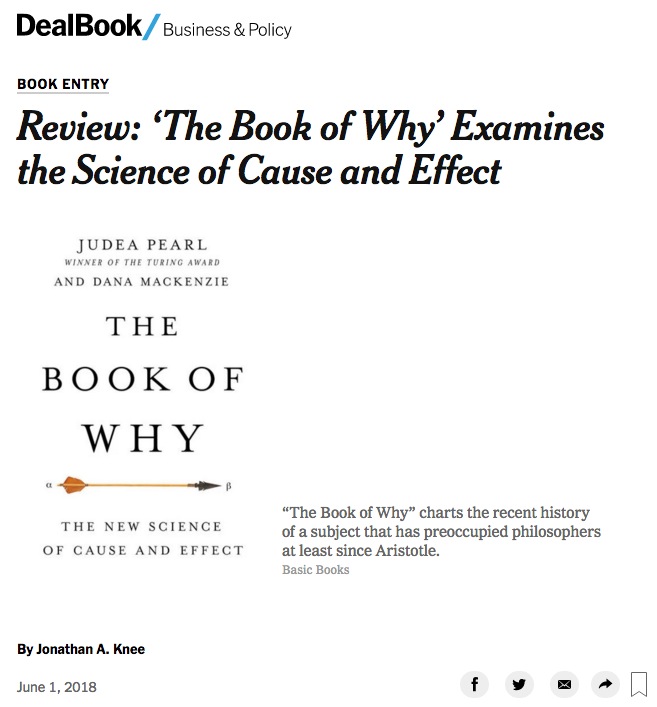Yesterday the first serious, in-depth review of The Book of Why appeared in The New York Times. This is the news that I have been holding my breath for over the last two weeks. I can see that the book is selling well. I can see that it has good customer reviews on Amazon.com. But what kind of judgement would the Arbiters of Taste in our society pronounce? Well, so far so good. I can now exhale.
There’s a lot to like about this review. Judea likes the fact that it does not focus exclusively on the application of causal inference to AI, which has received the lion’s share of the publicity so far. I can understand why; AI is a hot topic these days, and I think that our speculations on AI in the last chapter are (on purpose) possibly the most provocative part of the book. Nevertheless, it’s important to realize that the great majority of the book is about the application of causal reasoning to science more generally; how it has been under-utilized in the past and what possibilities are now offered by Judea’s new(-ish) mathematical techniques. (Actually, some of the work we describe in the book is almost 30 years old, so it is a little bit misleading to call it completely new.)
My favorite sentence in the review is this one:
The Professor Pearl who emerges from the pages of The Book of Why brims with the joy of discovery and pride in his students and colleagues.
It’s no accident that this is the portrait that emerges; Judea and I worked hard to bring out that joy of discovery. That was one area where I thought that, as a science writer, I could add value to the book: not just conveying the facts, but allowing the reader to enjoy the excitement of the chase.
Right after this, the reviewer brings up something I’ve been expecting to see somebody mention: the fact that we have some mathematical equations in the book. I just want to say, to any potential readers who might feel scared by this, that they are very few in number, and they are well motivated and explained. You should be able to understand our discussion even if you don’t understand the formulas. Why, then, do we include them at all? The answer lies exactly in the quote from Judea that the reviewer cites: “To me, a formula is a baked idea. Words are ideas in the oven.” Or to give another analogy: a formula is like a poem written in another language. You can explain it and explicate it in English, but still the experience is best if you read it in the language it was written in.
If I may be allowed to “review the review,” I would give it a solid A, and the only reason I don’t give it an A+ is that the reviewer, Jonathan Knee, doesn’t display a whole lot of passion himself. His review is pretty much a recap of the book, a Cliff’s Notes version. But this was probably appropriate for the venue. The review appears in the New York Times business section, whose readers probably want more of a “just the facts, ma’am” approach to a review: What’s in the book, and is it worth buying it? That’s exactly what Dr. Knee has given them. If this were in the New York Times Review of Books, I would expect a slightly different style of review.
In case you missed the link above, here it is again. And here is a screen shot!



